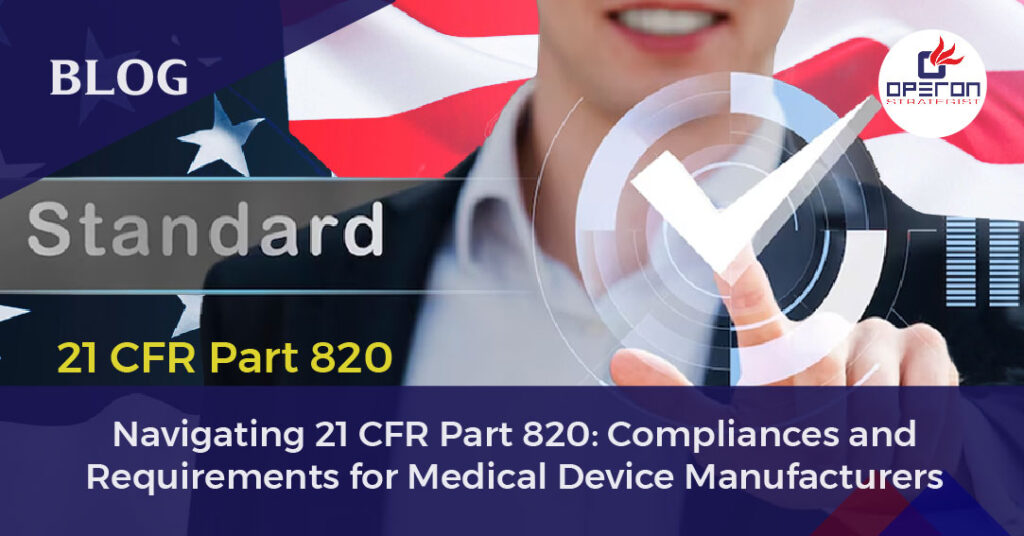Introduction:
Navigating the complex landscape of regulatory requirements is paramount for medical device manufacturers to ensure the safety and efficacy of their products. One crucial set of regulations is outlined in 21 CFR Part 820, also known as the Quality System Regulation (QSR), established by the U.S. Food and Drug Administration (FDA).
In this comprehensive guide, we’ll delve into the intricacies of 21 CFR Part 820, exploring its compliances and requirements for medical device manufacturers.
Understanding 21 CFR Part 820:
21 CFR Part 820 is a comprehensive set of regulations that delineates the current good manufacturing practice (CGMP) requirements for medical device manufacturers in the United States. These regulations are designed to establish a quality management system (QMS) that ensures the manufacturing of safe, effective, and compliant medical devices.
Looking For a Medical Device Regulatory Consultant?
Let’s have a word about your next project
Key Sections of 21 CFR Part 820:
- Scope and Definitions (Sec. 820.1 and Sec. 820.3): These sections outline the applicability and definitions used throughout the regulation, providing clarity on its scope and terminology.
- Quality System Requirements (Subpart B): Subpart B covers management responsibility, internal quality audits, and personnel, outlining regulations for quality policy, organizational structure, management review, quality planning, and personnel requirements.
- Design Controls (Subpart C): Subpart C focuses on design controls, ensuring that devices are designed according to their requirements. It includes requirements for design and development planning, design input, design output, design review, design verification, design validation, design transfer, design changes, and design history file (DHF).
- Document Controls (Subpart D): Subpart D pertains to document controls, encompassing regulations for document approval, distribution, and changes to ensure compliance without unnecessary documentation burdens.
- Purchasing Controls (Subpart E): Subpart E addresses purchasing controls, emphasizing the evaluation of suppliers, contractors, and consultants, along with purchasing data management.
- Identification and Traceability (Subpart F): Subpart F covers identification and traceability requirements, ensuring the ability to identify products throughout their lifecycle and trace defects back to their source.
- Production and Process Controls (Subpart G): Subpart G delves into production and process controls, including requirements for monitoring, validation, personnel, contamination control, equipment, materials, and automated processes.
- Acceptance Activities (Subpart H): Subpart H focuses on acceptance activities, outlining regulations for receiving, in-process, and finished device acceptance, as well as acceptance status determination.
- Nonconforming Products (Subpart I): Subpart I addresses nonconforming product control, including identification, review, disposition, and rework procedures.
- Corrective and Preventive Action (CAPA) (Subpart J): Subpart J covers CAPA requirements, emphasizing the identification, investigation, correction, and prevention of nonconformities.
- Labeling and Packaging Control (Subpart K): Subpart K pertains to labeling and packaging control, ensuring label integrity, accuracy, and appropriate packaging to prevent damage or alteration.
- Handling, Storage, Distribution, and Installation (Subpart L): Subpart L covers handling, storage, distribution, and installation requirements, focusing on preventing adverse effects during these processes.
- Records (Subpart M): Subpart M addresses recordkeeping requirements, including general requirements, device master record (DMR), device history record (DHR), quality system record (QSR), and complaint files.
- Servicing (Subpart N): Subpart N outlines requirements for servicing, including instructions, analysis, documentation, and reporting of service activities.
Statistical Techniques (Subpart O): Subpart O covers statistical techniques for establishing and verifying process capability and product characteristics.
Conclusion:
Compliance with 21 CFR Part 820 is essential for medical device manufacturers to ensure the quality, safety, and effectiveness of their products. By understanding and adhering to the regulations outlined in this comprehensive guide, manufacturers can navigate the complex regulatory landscape with confidence, ultimately contributing to the delivery of safe and reliable medical devices to patients worldwide.
For Expert 21 CFR Part 820 Compliance Guidance and FDA Requirements Assurance.
Operon Strategist: Your Partner in Ensuring 21 CFR Part 820 Compliance
Navigating the complexities of 21 CFR Part 820 can be daunting, but you don’t have to do it alone. At Operon Strategist, we specialize in guiding medical device manufacturers through the intricacies of regulatory compliance. Our expert team provides comprehensive support in establishing and maintaining a robust Quality Management System (QMS) that meets all FDA requirements. From initial setup to ongoing audits, we are here to ensure your products are safe, effective, and compliant.
Contact us today to learn how Operon Strategist can help you achieve seamless 21 CFR Part 820 compliance and bring your medical devices to market with confidence.
- adminhttps://operonstrategist.com/author/admin-2/
- adminhttps://operonstrategist.com/author/admin-2/
- adminhttps://operonstrategist.com/author/admin-2/
- adminhttps://operonstrategist.com/author/admin-2/




